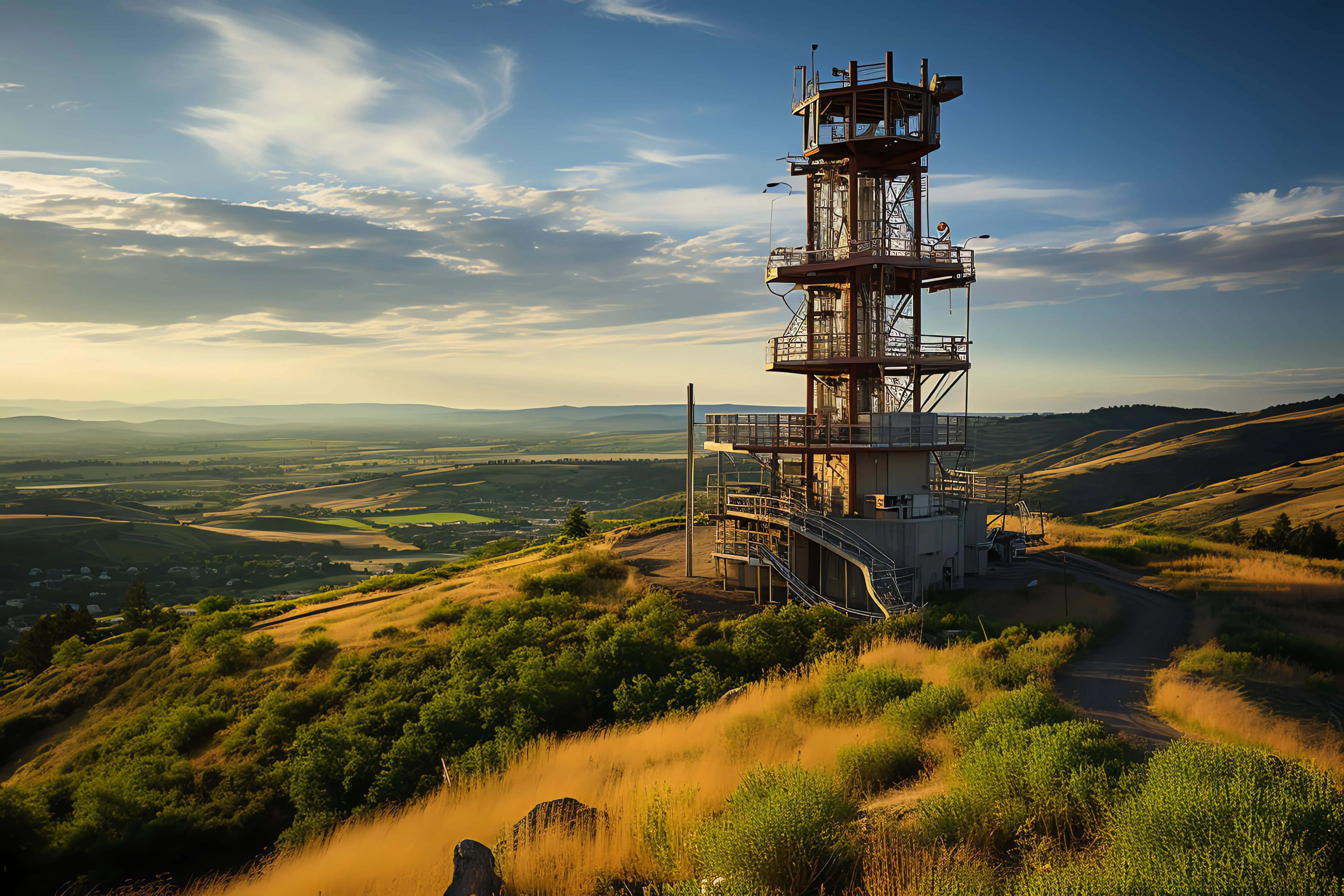Welcome to your comprehensive guide on pursuing a career in fire lookout jobs. This guide is tailored to assist both nature enthusiasts and those committed to the vital work of forest conservation and wildfire prevention. By choosing this path, you can enjoy breathtaking views and solitude and play a crucial role in protecting ecosystems and communities from the devastating effects of wildfires.
What to Expect
In the following sections, you’ll find detailed insights into what it takes to become a fire lookout, from the necessary qualifications and training to the role’s daily responsibilities and personal implications. We’ll also explore the benefits and challenges of the job, helping you determine whether this is the right career path for you.
Whether you’re a high schooler considering your future career options, a mid-career professional seeking a change, or anyone in between, our guide is designed to provide you with all the information you need to make an informed decision about fire lookout jobs. Let’s dive in and explore what it means to keep a watchful eye over our forests and natural resources.
Understanding Fire Lookout Jobs
Fire lookout jobs have played a critical role in forest management and wildfire prevention for over a century. Initially, the job involves serving as the eyes in the sky within remote locations. U.S. Forest Service Lookout Jobs workers watch for signs of smoke or fire in order to report and initiate a quicker response. The duties extend beyond merely watching for wildfires.
Skills and Attributes Needed
Those considering fire lookout jobs must have the following:
- Excellent observation skills to detect slight smoke signals.
- A high level of independence.
- Good communication skills for reporting findings.
Along with day-to-day tasks, these positions foster a deep connection with nature, often appealing to those who value solitude and environmental preservation.
Looking further into these roles, it’s clear that fire lookout jobs demand keen senses, patience, and passion for conservation. National Park Service on Fire Lookouts emphasizes the importance of these positions in maintaining the safety and beauty of our national parks.
Daily Responsibilities in Fire Lookout Roles
Fire lookout jobs involve meticulous daily routines that are crucial for early wildfire detection and ensuring the safety of surrounding areas. The role requires vigilance and strict adherence to a daily routine tailored to maximize observational coverage and data accuracy.
Typical Day-to-Day Tasks
The daily activities of a fire lookout may include:
- Visual scans of the environment are performed every hour.
- Using specialized equipment like Osborne Fire Finders to pinpoint the location of smoke or fire.
- Maintaining radio contact with the nearest forest service station.
- Updating logbooks with detailed observations and weather conditions.
Special Techniques and Tools
To effectively perform their duties, fire lookouts use a range of tools:
- Alidade: An essential tool for mapping fire locations.
- Topographic maps: These are used to identify the geographical features of an area.
- Weather instruments: These are used to record data such as wind speed and humidity.
These responsibilities are critical in managing and responding to potential wildfire outbreaks, ensuring that relevant departments are alerted promptly. Valuable training in these specialized tasks enhances the lookout’s ability to act decisively, underpinning the importance of their presence in remote forest areas.
Weather Safety and Wildfire resources provide further insight into how weather affects fire behavior, thereby influencing the strategies employed by fire lookouts.
Benefits of Choosing a Career as a Fire Lookout
Choosing a career in fire lookout jobs offers unique advantages that can be both personally and professionally rewarding. These roles provide a significant contribution to forest safety and environmental conservation.
Personal Fulfillment and Growth
Fire lookout roles offer:
- A peaceful workplace surrounded by nature.
- Opportunities for personal reflection and growth.
- A strong sense of purpose by protecting landscapes and communities.
Moreover, they provide a way to truly make a difference in the world of environmental preservation. Thus, fire lookout jobs are suited for those who cherish nature and solitude while contributing meaningfully to society.
For those contemplating this career, resources such as the Conservation Job Board can show how valuable these roles are within the conservation community.
Training and Requirements for Fire Lookout Jobs
Certain training and educational requirements must be met to pursue fire lookout jobs. This preparation ensures that individuals are equipped to handle the demands and responsibilities of the job effectively.
Educational Requirements
While specific requirements can vary by location and agency, generally, candidates need:
- A high school diploma or equivalent.
- Prefers knowledge in environmental science or forestry.
- First aid and CPR certification.
Training Programs
Aspiring fire lookouts typically undergo specialized training that includes:
- Wildfire detection and reporting techniques.
- Use of fire observation tools and equipment.
- Survival skills for remote and rugged conditions.
Governmental and environmental organizations often offer such training programs. Participants learn crucial skills that directly relate to their job roles.
Finding Fire Lookout Jobs: Tips and Resources
Securing a position as a fire lookout requires knowing where to look and how to prepare effectively. Here are some practical steps and resources to help you start your career in this field.
Job Search Strategies
Effective methods to find fire lookout jobs include:
- Checking federal and state government job portals regularly.
- Connecting with local conservation groups and forestry services.
- Attending job fairs focused on outdoor and environmental careers.
Key Resources
Certain job listing websites and platforms provide valuable listings for fire lookout opportunities:
- USAJobs.gov – Official job site for the United States federal government.
- Conservation Job Board – Specializes in fire-related positions.
Moreover, enhancing your resume with relevant certifications and volunteering for related roles can significantly boost your visibility to prospective employers. Also, remember the timing; fire lookout jobs are often seasonal, peaking in spring and early summer. Staying informed and applying early can set you apart.
For more insights, visit the Bureau of Labor Statistics for job outlook and trends in environmental protection careers.
Challenges Faced in Fire Lookout Jobs
While fire lookout jobs offer unique rewards, they also come with substantial challenges. Understanding these difficulties helps prepare aspiring lookouts for the realities of the job.
Isolation and Psychological Strain
One of the most significant challenges is the isolation:
- Many lookouts are stationed alone in remote towers for days or weeks.
- This solitude can impact mental health without proper preparation and support.
Environmental Conditions
Fire lookouts must also weather the natural elements:
- Extreme weather conditions, from intense heat to thunderstorms, are common.
- Remote locations mean limited immediate access to medical care.
Constant Vigilance
The core duty of fire surveillance requires uninterrupted focus:
- Long hours watching for smoke can strain the eyes and increase fatigue.
- Maintaining high alertness levels is crucial but challenging.
Despite these challenges, many find the role fulfilling. Support systems and proper training are critical. For insights into coping mechanisms and support for solitary roles, the Substance Abuse and Mental Health Services Administration (SAMHSA) offers resources on mental health. Moreover, checking Fire Safety Jobs might provide opportunities where these challenges are more manageable.
FAQs
Aspiring fire lookouts often have questions about the specifics of this unique role. Here, we address the most common inquiries to help clarify the nature of fire lookout jobs.
What is the typical duration of assignments in fire lookout jobs?
Assignments can vary greatly, depending on location and fire risk, from a few days to several months during the fire season.
Can fire lookouts work year-round?
Jobs are mostly seasonal, aligning with the peak fire season, which can vary by region. However, some positions might offer year-round employment based on local climate and needs.
What are the living conditions like for fire lookouts?
Living conditions are quite basic and isolated. Fire lookouts often stay in cabins or fire towers with minimal amenities, focusing on sustainability and efficiency.
How do fire lookouts communicate emergencies?
Fire lookouts use radios and sometimes satellite phones to report any signs of fire or smoke to forest management or fire departments immediately.
Is there specific training for emergency situations?
Yes, fire lookouts receive training in emergency response, first aid, and sometimes even wilderness first responder courses to prepare for potential situations.
Addressing these FAQs helps those interested in fire lookout jobs understand what to expect and how to prepare for this critical and rewarding field.
Conclusion
Fire lookout jobs present a unique opportunity to contribute significantly to forest conservation and wildfire prevention. These roles require diligence, a keen eye for detail, and a passion for environmental stewardship. By understanding the responsibilities, challenges, and rewards of this career, you can better prepare for a fulfilling job that protects natural landscapes and supports broader environmental goals.
Take the Next Step
If you’re inspired to pursue a career as a fire lookout or in any role that supports diversity and inclusion in the workplace, consider joining Diversity Employment.
Explore new opportunities, connect with like-minded professionals, and start your journey towards a meaningful career in fire lookout or any other diverse role. Join Diversity Employment today and take a step towards a rewarding and impactful career.




